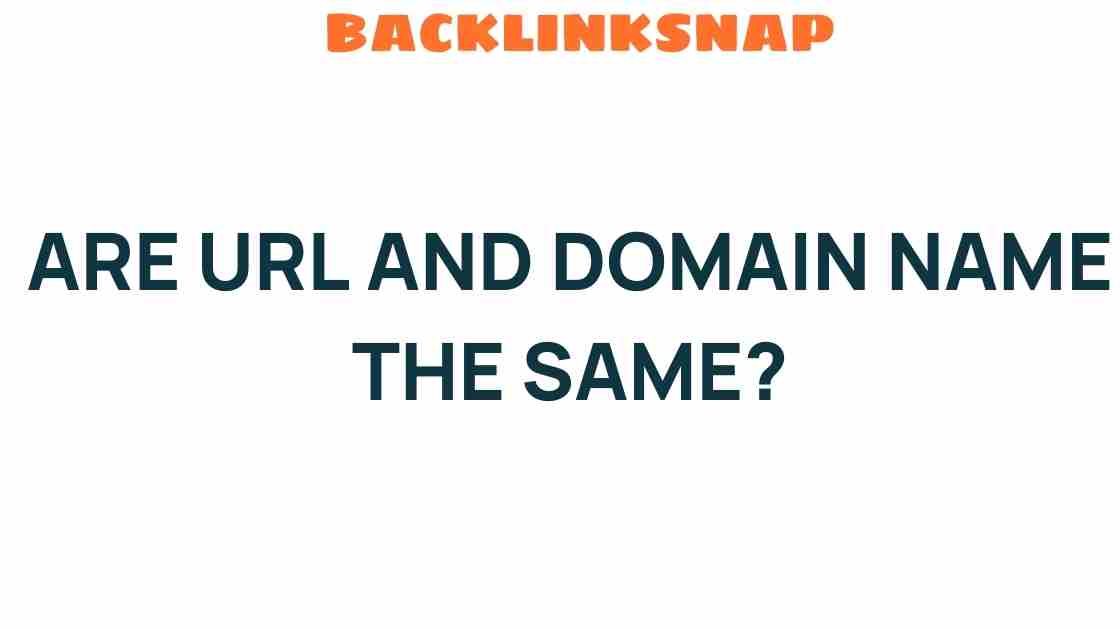Are URL and Domain Name the Same? Unraveling the Digital Mystery
In the vast expanse of the internet, two terms often come up in discussions about online navigation: URL and domain name. While many people use these terms interchangeably, they represent distinct concepts in the world of web addresses. Understanding the differences between these two elements is crucial for anyone looking to enhance their digital identity or improve their website’s structure and SEO. Let’s dive into the intricacies of these terms, their roles in online navigation, and how they contribute to a coherent internet experience.
Defining the Basics: What is a URL?
A URL, or Uniform Resource Locator, is the full web address you enter into a browser to access a specific resource on the internet. It contains several components that provide information about the resource’s location and how to retrieve it. A standard URL looks like this:
https://www.example.com/path/to/resource
This URL can be broken down into several parts:
- Protocol: The “https://” in the URL indicates the protocol used for communication, with “http” and “https” being the most common.
- Domain Name: Here, “www.example.com” is the domain name, which we will delve into shortly.
- Path: The “/path/to/resource” specifies the exact location of a resource on the server.
Understanding Domain Names
Now, let’s shift our focus to the domain name. This is essentially the human-readable address that points to an IP address on the internet. Every website has a unique domain name that serves as its digital identity. For instance, in the URL above, “example.com” is the domain name.
Domain names are composed of two main parts:
- Second-Level Domain (SLD): This is the part before the last dot (e.g., “example”). It often represents the name of the organization or individual.
- Top-Level Domain (TLD): This is the last part of the domain name (e.g., “.com”, “.org”, “.net”). TLDs can indicate the type of organization or geographical location.
So, Are They the Same?
To answer the question directly: no, a URL and a domain name are not the same. The domain name is just one component of a URL. While the domain name directs users to a specific website, the URL provides a complete path to a specific resource within that site. To put it simply, every domain name is part of a URL, but not all URLs are domain names.
The Importance of Understanding These Terms
Grasping the distinction between URLs and domain names is essential for various reasons:
- Website Structure: Knowing how URLs are structured helps in organizing content effectively, which is vital for user experience and SEO.
- SEO Strategy: Search engines analyze both the URL and domain name to index and rank websites. A well-structured URL can boost your site’s visibility.
- Online Navigation: Users often rely on URLs to navigate the web. Clear and concise URLs can enhance the user experience, encouraging visitors to explore more content.
SEO Considerations for URLs and Domain Names
When it comes to SEO, both URLs and domain names play critical roles:
- Keywords in URLs: Including relevant keywords in your URLs can improve search engine rankings. For example, a URL like
https://www.example.com/best-coffee-recipesis more effective thanhttps://www.example.com/12345. - Domain Authority: The choice of a domain name can influence your site’s authority. A domain that reflects your niche can help in establishing trust with your audience.
- Readability: Search engines prefer URLs that are easy to read and understand. Avoid using long strings of numbers or irrelevant characters.
Real-World Applications and Personal Insights
As someone who has worked extensively in digital marketing and website development, I’ve seen firsthand how crucial it is to get these elements right. For instance, when I was developing a blog for a client, we spent time brainstorming a domain name that encapsulated their brand while ensuring that the URLs for each blog post were descriptive and keyword-rich. This not only improved their SEO performance but also made it easier for users to understand what each post was about at a glance.
FAQs About URLs and Domain Names
1. Can a URL work without a domain name?
No, a URL cannot exist without a domain name since the domain name is a critical part of the URL structure.
2. How do I choose a good domain name?
Choose a domain name that is short, memorable, and relevant to your content. Avoid using hyphens or numbers where possible.
3. Are subdomains part of a URL?
Yes, subdomains (like blog.example.com) are part of a URL and can help organize content within a domain.
4. What is a URL shortener, and why is it useful?
A URL shortener condenses long URLs into shorter, more manageable links. This is especially useful for sharing links on social media or in print.
5. Can a website have multiple domain names?
Yes, a website can have multiple domain names that point to the same content. This can help with branding and capturing different variations of a name.
6. How do I check if a domain name is available?
You can use various online domain registrars to check the availability of a domain name. Websites like Namecheap provide this service.
Conclusion
In summary, while the terms URL and domain name are often used interchangeably, they represent different aspects of the online landscape. A domain name serves as the fundamental identifier for a website, while a URL provides the complete address to access specific resources. Understanding these differences is crucial for anyone involved in online navigation, website structure, and SEO. By grasping the nuances of internet terminology, you can enhance your digital identity and improve your online presence.
For more information on internet basics and to expand your knowledge further, consider visiting W3Schools for comprehensive tutorials and resources.
This article is in the category SEO Optimization and created by BacklinkSnap Team




